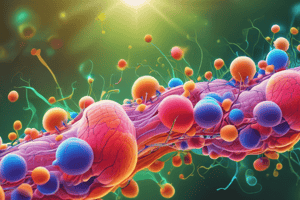Podcast
Questions and Answers
Cellular respiration is the process by which energy in the form of ATP is released from food molecules.
Cellular respiration is the process by which energy in the form of ATP is released from food molecules.
True (A)
The energy stored in food is converted into adenosine triphosphate (ATP) before being used by the body.
The energy stored in food is converted into adenosine triphosphate (ATP) before being used by the body.
True (A)
ATP is composed of a sugar (ribose) bound to an organic base (adenine) and a chain of two phosphate groups.
ATP is composed of a sugar (ribose) bound to an organic base (adenine) and a chain of two phosphate groups.
False (B)
The ATP molecule transfers the energy captured during respiration to the many sites that use energy in the cell.
The ATP molecule transfers the energy captured during respiration to the many sites that use energy in the cell.
Cells use ATP through exergonic reactions, where a phosphate group split from ATP activates a protein, catalyzing an exergonic process.
Cells use ATP through exergonic reactions, where a phosphate group split from ATP activates a protein, catalyzing an exergonic process.




